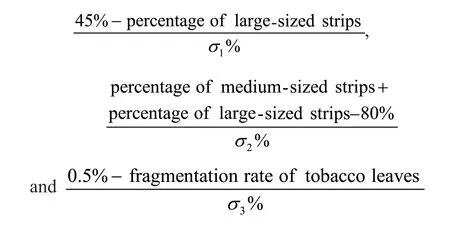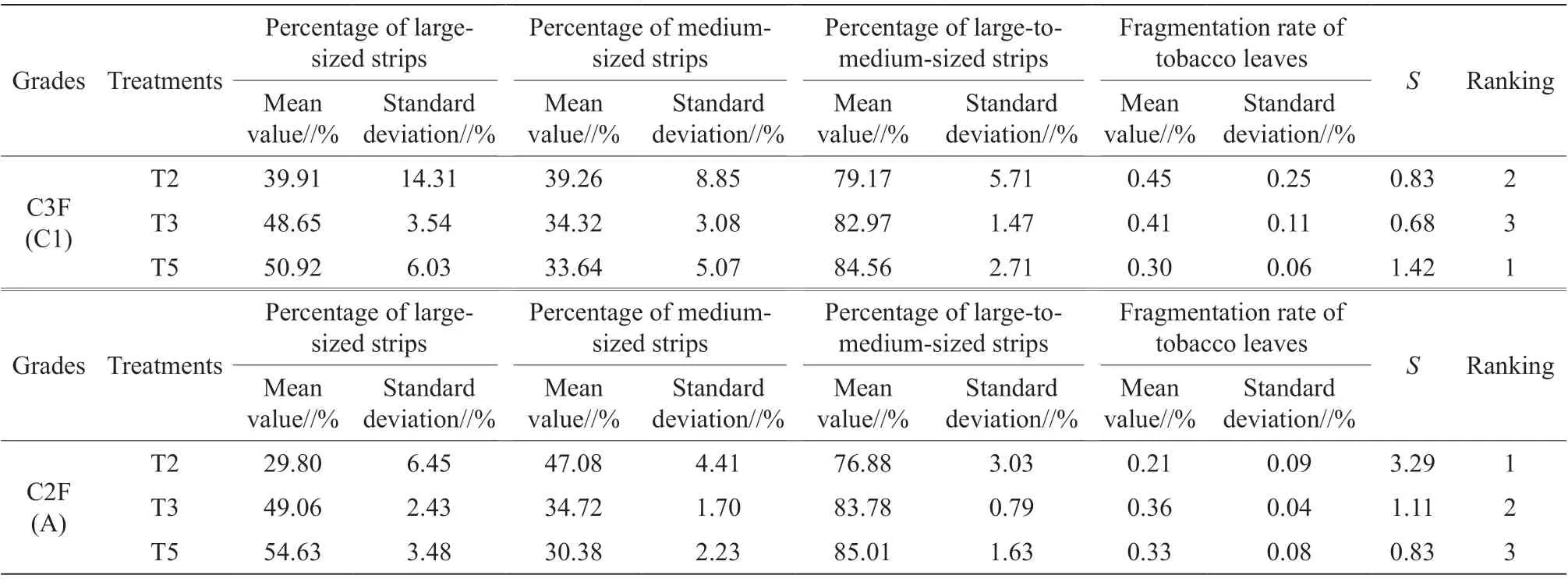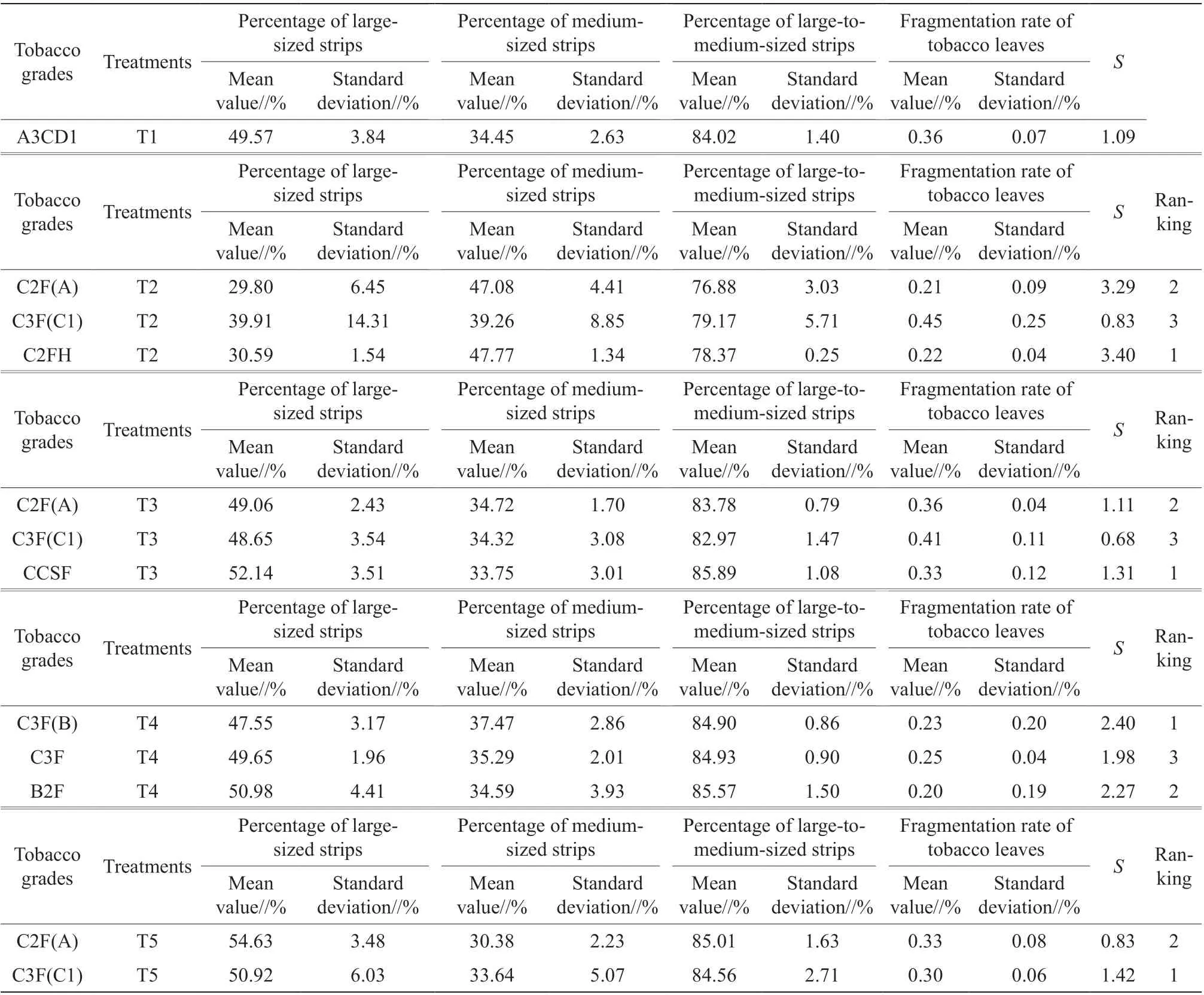Influence of Shape and Size of Threshing Frame and Tobacco Grade on Leaf Strip Structure
CHEN Zhuang-yu, HE Ze-jun, LI Ye-chun, HUANG Jing, HUANG Ya-fei
1. Chenzhou Redrying Factory, Hunan Tobacco Redrying Co., Ltd, Chenzhou 423000, PRC;
2. School of Electrical & Information Engineering, Changsha University of Science and Technology, Changsha 410114, PRC
Abstract This paper focused on the influence of the shape and size of threshing frames as well as the grades of tobacco leaves on the structure of threshed leaves. The testing tobacco leaves all came from the hilly ecological region of Nanling and belonged to burnt sweet, alcoholic sweet and scent category. The comprehensive evaluating value S was taken as the test index. Results showed that, without considering the influence of tobacco grade on leaf structure, the shapes of first-stage thresher five-link frames were all hexagons, and the combination with the sizes of 3.5, 3.0, 3.5, 3.0, 3.0 inches had the highest evaluating value S of 2.49. For tobacco grade C2FH, the shapes of first-stage thresher five-link frames were also hexagons, and the evaluating value S reached the highest value of 3.40 with sizes of 3.5, 3.0, 3.5, 3.0, 3.0 inches. Comprehensive analysis showed that: 3.0 inch frame performed better in controlling the percentage of large-sized strips than 3.5 inch frame did; rhombic frames were better than hexagon frames in reducing the breakage rate of tobacco leaves; different shapes or sizes of nonadjacent two-link frames can help to improve the threshing quality.
Key words Threshing frame; Leaf strip structure; Percentage of medium-sized strips; Shape and size
1. Introduction
With the full use of strips, the threshing and redrying become a critical process in the industrial production of cigarettes. Nevertheless, current threshing and redrying process is featured with unreasonable leaf strip structure, high percentage of large-sized strips, as well as other problems. Therefore, the threshing concept of “controlling largesized strips involving increasing medium-sized strips and reducing fragmentation of tobacco leaves”, has become a consensus among redrying factories. As per technical specification of threshing and redrying process, the frame and roller speed should be technically adjusted according to the types, grades and varieties of tobacco during the threshing and destemming process[1]. The frame is a key part in a thresher to control strip structure and determine stripping efficiency. LIU L Fet al.[2]found that, compared with 3.5 inch frame, 3.0 inch frame yielded higher percentage of large-to-medium-sized strips, medium-sized strips and long stems with lower fragmentation rate of tobacco leaves. By improving the hole size of frames, LI Xet al.[3]managed to increase the threshing quality of C3F grade tobacco leaves, with the percentage of large-to-mediumsized strips increased from 86.9% to 87.6% and the percentage of oversized strips reduced from 26.2% to 21.6%. The experimental results of CAI L Het al.[4]also indicated that reducing the frame size can lower the percentage of large-scaled strips, increase the tobacco breakage, and decrease the strips yield slightly.
The shape of frame also influences the leaf strip structure significantly. KONG Xet al.[5]found that replacing the rhombic frames with hexagon frames can improve the uniformity of leaf strip structure, with the large-sized strips reduced by 13%, the mediumsized strips increased by 12%, and the stem content decreased by 0.5%. GAO Wet al.[6]discovered that, after adjusting to the structure with dense rhombic frames and triangle arrangement of threshing blades and with unchanged percentage of large-to-mediumsized strips and fragmentation rate of tobacco leaves, the percentage of large-sized strips was reduced by 6.55% and the percentage of medium-sized strips was increased by 6.35%. XU Qet al.[7]found that 3.2 inch hexagon frame can help to reduce the percentage of large-sized strips and stem content in tobacco leaves.
After years of experiments and production practices, redrying factories have acquired certain rules about frame size influencing the leaf strip structure. However, the results of the studies varied a lot due to different tobacco grades and processing parameters. The evaluation of leaf strip structure involves multiple technical indexes, such as the percentage of large-sized strips, percentage of medium-sized strips, percentage of large-to-medium-sized strips, fragmentation rate of tobacco leaves, and dust content in strips,etc. Different frame sizes and arrangements also presented different effects on the indexes. It is therefore hard to determine which threshing method could yield the best result[8-11]. In 2016, the State Tobacco Monopoly Administration enacted theCigarette Making Process Specification(herein referred to asThe Specification), which included threshing and redrying process into the standardized file system ofThe Specificationand raised the requirements of “controlling large-sized strips involving increasing medium-sized strips and reducing fragmentation of tobacco leaves”[12]. Based on the statistics of the production test data of 2019 tobacco drying season of Chenzhou Tobacco Redrying Co., Ltd., the comprehensive evaluating valueSwas established to evaluate the threshing quality, and the influences of different threshing shape and size portfolios in the first-order threshing unit and the tobacco grades on the leaf strip structure were studied to provide theoretical basis for defining an appropriate threshing shape and size portfolio.
2. Materials and Methods
2.1. Test materials
The burnt sweet, alcoholic sweet and scent type tobacco leaves totally eight grades (A3CD1, B2F, C2F(A), C2FH, CCSF, C3F, C3F(B) and C3F(C1)) all came from hilly ecological region of Nanling provided by Chenzhou Redrying Factory of Hunan Redrying Co., Ltd.
2.2. Equipment and instruments
Griffen 12 000 kg/h threshing and redrying production line (Griffen Company, USA), AFA441 Thermo Nicolet near-infrared spectrometer (Nicolet Instrument Corporation, USA), SKALAR segmented flow analyzer (Skalar Analytical B.V., Netherlands), Thomas Model-4 Wiley Mill (Thomas-Wiley, USA), MT-C Brabender Moisture Tester (Brabender GmbH & Co. KG, Germany), and RX-29-10 Ro-Tap rotary vibration sieve (Ro-Tap Company, USA).
2.3. Methods
Based on the statistics of the threshing and redrying data of 2019 tobacco drying season of Chenzhou Tobacco Redrying Co., Ltd., the influences of the frame shape and size on the leaf strip structure after threshing especially on the percentage of largesized strips, medium-sized strips and fragmentation of tobacco leaves were analyzed. “Rhombus 2.5” was chosen for the shape and size of all second-stage thresher two-link frames, and “round 2.5” was chosen for the shape and size of third-stage, fourth-stage and fifth-stage thresher one-link frames. This paper only analyzed the shape and size portfolios of five-link frames of first-stage thresher. There were totally five portfolios as shown in Table 1.

Table 1 Frame shapes and sizes of first-stage thresher inch inch
2.4. Evaluation index
The threshing quality indexes specified inQuality Standards for Tobacco Threshing and Redryingmainly include: percentage of large-sized strips (>25.4 mm), percentage of medium-sized strips (12.7~25.4 mm), percentage of small-sized strips (6.35~12.7 mm), fragmentation rate of tobacco leaves (2.36~6.35 mm), dust content in strips (<2.36 mm), thick stem content (diameter≥2.38) and stem content (diameter≥1.5 mm)[6-8]. Considering the mutual coupling relationship between the indexes in the leave strip structure, only the percentage of large-sized strips, the percentage of medium-sized strips, and the fragmentation rate of tobacco leaves were used as the evaluation indexes of leave strip structure in this paper. The specification has clear quality requirements for leaf strip structure after threshing: the percentage of large-sized strips should be lower than 45%, the percentage of largeto-medium-sized strips should be higher than 80%, and the fragmentation rate of tobacco leaves should be lower than 0.5% after separation of stems. In order to evaluate the five threshing frame portfolios, the comprehensive evaluating valueSwas established. The higher theSvalue, the better the corresponding treatment.

where,w1,w2andw3represented the influence weights of the percentage of large-sized strips, the percentage of medium-sized strips, and the fragmentation rate of tobacco leaves, respectively. These values indicated the importance of the corresponding indexes. σ1, σ2and σ3were the variances corresponding to percentages of large-sized strips, the percentage of medium-sized strips, and the fragmentation rate, which were set as 7.83, 5.40 and 0.15 respectively in this paper.were the normalization ratio of the percentage of large-sized strips, the percentage of medium-sized strips, and the fragmentation rate, respectively. The higher the values, the better they satisfied the requirements of “percentage of large-sized strips <45%”, “percentage of large-to-medium-sized strips >80%” and “fragmentation rate of tobacco leaves <0.5%”. In this paper, the weights were set as:w1=1,w2=1 andw3=1.

2.5. Statistical analysis of data
SPSS V26.0 and Excel 2010 were applied for data analysis and processing.
3. Results and Analysis
3.1. Influence of different shapes and sizes of threshing frame on leaf strip structure
Table 2 presented the mean value of the strip structures under different treatments without considering the influence of tobacco grades on the processing technique. As shown, T2 had the highest comprehensive evaluation index owing to its significantly low percentage of large-sized strips after threshing compared with other treatments, and its percentage of medium-sized strips was much higher than other treatments. With the alternate setting of 3.0 inch frame and 3.5 inch frame, T2 presented better leaf strip structure than T1 and T3 with simple 3.0 inch or 3.5 inch frames did. Nevertheless, excessively low percentage of large-sized strips has made the overall percentage of large-to-medium-sized strips lower than 80% with high fragmentation rate. The comprehensive evaluation index of T4 was 2.23, the second in the five treatments. Compared with T1 and T3, T4 properly used rhombic frame instead of hexagon frame in the air separator, which helped to reduce the fragmentation rate. However, it should be noted that the dispersion of the T2 leaf structure was very high and the standard deviation of the percentage of large-sized strips was as high as 10.04%, indicating that the portfolio could be easily affected by other threshing techniques and result in unstable strips yield.

Table 2 Influences of five frame portfolios on leaf strip structure
3.2. Influence of different frame portfolios on leaf strip structure with the same tobacco grades
The research data were collected from actual production, hence it lacked sufficient data to compare the leaf strip structures of the same type tobacco under five different threshing portfolios. This paper only presented the statistical results of the leaf strip structures of grade C3F(C1) and grade C2F(A) tobacco under T2, T3 and T5 treatments, as shown in Table 3.
With the same tobacco grades, different frame portfolios had certain influences on the leaf strip structure after threshing. For C3F(C1) tobacco, T5 had the lowest fragmentation rate when the percentage of large-to-medium-sized strips was satisfied, resulting in the highest comprehensive evaluation index. T2 had the lowest percentage of large-sized strips and highest percentage of medium-sized strips, whereas the percentage of large-to-medium-sized strips was only 79.17% and it had the highest fragmentation rate. Therefore, it can be concluded that the lowest percentage of large-sized strips and highest percentage of medium-sized strips were reached by sacrificing the fragmentation rate. Furthermore, the high dispersion of the indexes of the leaf strip structure under T2 after threshing was also one of the causes to the high fragmentation rate. As for C2F(A) tobacco, the percentage of large-sized strips and fragmentation rateof T2 were properly controlled, and the percentage of medium-sized strips was obviously better than other two treatments, resulting in higher comprehensive evaluation index than other two treatments. Different grades of tobacco could have different threshing effects under T3 and T5. The performance of T3 in controlling the percentage of large-sized strips and improve the percentage of medium-sized strips was obviously better than T5, whereas it yielded relatively higher fragmentation rate. Therefore, after weighing the pros and cons of the indexes, for circumstances with higher requirement of fragmentation rate during production, a proper use of rhombic frames was recommended to replace hexagon frames to reduce fragmentation rate.

Table 3 Influence of different treatments on leaf strip structure with same tobacco grade
3.3. Influence of tobacco grades on leaf strip structure under same frame portfolio
Table 4 summarized the leaf strip structure of different grades of threshed tobacco during the 2019 tobacco drying season of Chenzhou Tobacco Redrying Factory. In T1, only A3CD1 tobacco leaves were produced. The overall result indicated high percentage of large-sized strips and the comprehensive evaluation index was 1.09. In T2, the C2F(A), C3F(C1) and C2FH leaves were produced in a large scale. The results were shown as Table 4. C2F(A) and C2FH showed low percentage of large-sized strips and high percentage of medium-sized strips, the comprehensive evaluation index of which was as high as 3.29. C3F(C1) had higher fragmentation rate than the other two grades, resulting in low comprehensive evaluation index. As shown in Table 2, the grade of tobacco leaves should be considered when threshed under T2. The difference of the threshing with different grades was not significant in T3, and the threshing effect was stable. The comprehensive evaluation indexes of each tobacco grade under T4 were all about 2, making T4 the most stable treatment in terms of threshing property among the five treatments. Therefore, an alternate setting of rhombic frame and hexagon frame can be a preferred option for production given that the specific influence of tobacco grades on threshed leaf strip structure is unknown or frequent processing of different tobacco grades is needed during production. In T5, although the percentage of large-to-mediumsized strips of C2F(A) and C3F(C1) tobacco satisfied the requirement of 80%, further analysis showed a large proportion of large-sized strips and a low comprehensive evaluation index.
To sum up, tobacco grades had certain influence on the threshing results, especially for T2 and T5. The comprehensive evaluating indexSof the leaf strip structure showed that the highestSvalue of T2 was 3.40 and the lowest was 0.83. Therefore, special attention should be paid to the tobacco grades when using T2 frame.
4. Conclusion
(1) The comprehensive evaluating index of threshing was constructed based on actual productionpractices. The threshing of different grade tobacco under different frame portfolios was evaluated. The index can largely reflect the threshing concept of “controlling large-sized strips, involving increasing medium-sized strips and reducing fragmentation of tobacco leaves”. However, the weights of the indexes need further refinement according to the demands of tobacco factories and users.

Table 4 Influence of tobacco grades on leaf strip structure after threshing under same frame portfolio
(2) Frame portfolio had certain influence on threshed leaf strip structure when tobacco grade was not considered. 3.0 inch frame performed better in controlling the percentage of large-sized strips than 3.5 inch frame did; rhombic frames were better than hexagon frames in reducing the fragmentation rate of tobacco leaves; different shapes or sizes of nonadjacent two-link frames can help to improve the threshing quality.
(3) The leaf strip structures with different tobacco grades under same frame portfolio varied significantly. T2 was a relatively good frame shape and size portfolio. However, the tobacco grade should be accounted for before using T2. In the case that tobacco grades were changed frequently during production, it is recommended to use T4 treatment which had a good stability with alternate setting of rhombic frame and hexagon frame for threshing.
 Agricultural Science & Technology2020年3期
Agricultural Science & Technology2020年3期
- Agricultural Science & Technology的其它文章
- Optimization of Liquid Seed Medium for Grifola frondosa
- Effects of Different Phosphorus Application Rate on the Growth and Development, Yield and Quality of Tobacco in Yongzhou Area
- Evaluation of Ecological Environment Competitiveness of Hunan Province Based on Prefecture Level Cities
- Feasibility of Wheat Bran as the Sole Nutrient Source of Platymonas helgolandica var. tsingtaoensis
- Effects of Biological Bacterial Fertilizer on Carbon Metabolism Characteristics of Rhizosphere Soil Bacteria in Rice
- Breeding of High Quality Indica CMS Line Xinlong A
